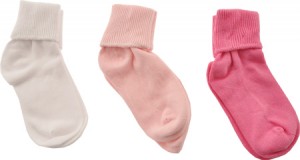Is that a few pairs of socks, or three pair? I’ve never really understood the logic of that “singular plural” of pair, whose usage seems to me to be especially common here in America.
A Google search on the term “three pair of” produces 3,300,000 results (which seems strangely symmetrical, even though the expression sounds decidedly wrong). Now if we make those pairs properly plural — ie. “three pairs of” — and hit the Google button again, we have almost 12 times as many results (38,300,000). “Two pair of” on the British National Corpus turns up just 4 results, whereas adding an ‘s’ to pair takes us up to 157. On the Corpus of Contemporary American English, those figures are 36 and 484 respectively. So I think it’s safe to say that on both sides of the Atlantic, the logical plural with an ‘s’ wins out usage-wise.
Most usage guides prescribe “pairs” for its plural form, including Garner’s Modern American Usage, Fowler’s Modern English Usage, and Patricia O’Conner’s Woe Is I. Fowler states simply that “the plural form pairs is desirable after a numeral (e.g. seven pairs of jeans). The type seven pair of jeans is non-standard, at least in Br.E [British English].” Is he implying that the plural pair is an Americanism? Well, Garner shares Fowler’s preference, but does acknowledge the widespread non-standard option : “The preferred plural of pair is pairs. In nonstandard usage, pair often appears as a plural.” I wonder if it is considered more correct in the New World …
According to Merriam-Webster, “the usual plural is pairs, when there is no preceding number or indicator of number (as several).” It gives “conflicting pairs of truths” as an example. But unlike the more traditional sticklers above, M-W concedes, strangely, that “when a number or indicator of number precedes pair, either pair or pairs may be used,” going on to cite examples such as “six pair of pants” and “three pairs of oars.” American Heritage recognizes that while “pairs” is the more common plural form, “pair” is not incorrect. It qualifies that “pair” or “pairs” can be used after a number other than one, “but the plural is now more common: She bought six pairs (or pair) of stockings.”
The word pair dates back to the mid-13th century, from the Old French paire meaning “pair, couple,” and directly from Medieval Latin paria meaning “equals”. It originally referred to things, and began to describe people from the late 14th century. Meaning “a woman’s breasts” is attested from 1922, according to the Online Etymology Dictionary. Who knew.
Perhaps more curious is why certain household objects and items of clothing are referred to as a pair when they’re singular items, such as a pair of scissors, two pairs of spectacles, several pairs of jeans, and 100 pairs of underwear. That blades, lenses, and trouser-legs come in twos probably explains the first few, but the mind boggles a bit about the last. According to World Wide Words, “the answer to all this conventional plurality is very simple. Before the days of modern tailoring, such garments, whether underwear or outerwear, were indeed made in two parts, one for each leg. The pieces were put on each leg separately and then wrapped and tied or belted at the waist (just like cowboys’ chaps). The plural usage persisted out of habit even after the garments had become physically one piece. However, a shirt was a single piece of cloth, so it was always singular. It’s worth noting that the posher type of tailor, such as in London’s Savile Row, still often refers to a trouser and the singular pant and tight are not unknown in clothing store terminology in America — so the plural is not universal.”

